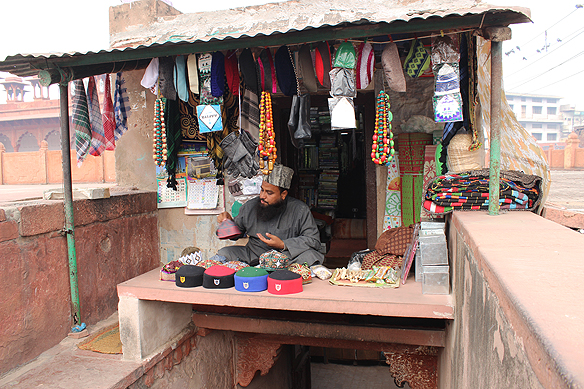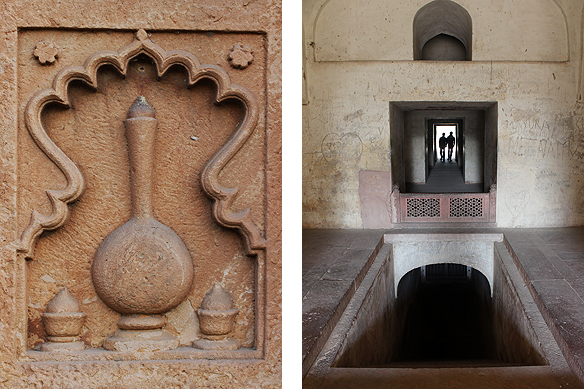
So, you’ve ticked off Agra’s major sights, the raison d’êtres for your visit. Or maybe it is your umpteenth time to the city. What now?
After marvelling at Agra’s treasures [listed from 1 to 6 in this series in no specific order] I wanted to experience yet more of it. Beyond the Agra the travel and history guides enthused about. And I was not disappointed. Digging and wandering through its centuries old lanes, having heartfelt conversations with its present residents, I saw sides of it which further justified its place in a traveller’s bucket list, equal to its more celebrated attractions. Don’t believe there is more to Agra than its UNESCO World Heritage Sites and Mughal masterpieces? Read on and be pleasantly surprised, like I was. 🙂
1. Dig into a Pay-What-You-Want meal at Cafe Sheroes Hangout


Meet Nisha. She was doused with acid when in her teens. Reason. Family enmity. A “jealous” uncle wanted to get back to her family by searing their girl child alive. Acid, till recently, was readily available across the counter in India. It still is in many small towns. Unrequited love is the other most common reason behind this rampant, hideous act.
In a world obsessed with skin deep beauty, being stripped of one’s skin itself is more traumatic than words can express. Yet some of these girls have found their light back. And it shines bright. This has been possible because of the work of a young, brave non-profit: Sheroes Hangout, a food café run by survivors of acid attack violence. Part of the Stop Acid Attacks campaign launched on 8 March 2013, the cafes currently run in Lucknow and Agra. None of the items are priced. Pay what you want over a conversation with these young women, and you will not only help a cause, but come out feeling inspired by their strength.
Where is it? Sheroes Hangout, Fatehabad Road, Opposite the Gateway Hotel.
2. Explore the tomb of Mariam Zamani, the Hindu consort of Mughal Emperor Akbar and mother of Emperor Jahangir


Whether Jodha Bai of Jodha Akbar, the historical magnum opus by Sanjay Leela Bansali fame, ever really existed is debatable. There is no mention of any woman by that name in the official records written either during her husband Akbar or her son Jahangir’s reign. The appellation was made in the 19th Century for the first time by an Oriental scholar-author—James Tod.
Who did exist was a Hindu daughter offered in marriage in 1562 to the Emperor Akbar by her father Raja Bharmal Kachhwaha of Amer, Jaipur, as a sign of Rajput submission to the Mughal empire. The nameless lady rose in importance in the imperial palace when she gave birth to Akbar’s first heir, earning herself the title “Mariam Zamani” [Compassionate to the World]. Whilst most Mughal queens have been forgotten over time, her role in giving the hitherto heirless emperor a successor is celebrated in a grand and graceful red sandstone dome-less tomb. It was built over a previous Lodi pavilion by her son Jahangir on her death, aged 81 in 1623.
Where is it? Mathura-Delhi Highway, 500 metres ahead of Sikandra, Akbar’s tomb.
3. Unwind at the 350-year-old Jama Masjid built by Emperor Shah Jahan’s daughter Jahanara Begum Sahib in the old city of Agra


Untouched by the vagaries of time or modern-day tourists, Jama Masjid in Kinari Bazar in the heart of the old city is straight out of the mists of medieval Mughal India. The muezzin still calls the faithful to prayer who perform wudu in the central courtyard followed with salah in the arcaded prayer chamber. Little boys and girls still learn about Islamic theology at the madrasah no differently from their ancestors when they too were children.
One of the largest, and perhaps most tranquil mosques in the country, the red sandstone edifice embellished with white marble mosaic is neither ornate in design nor decoration; yet it oozes charm. The mosque was commissioned and paid for by a royal Sufi princess called Jahanara Begum Sahib (1614 – 1681) in 1648 at a cost of Rs. 500,000 from her personal allowance. Jahanara was emperor Shah Jahan’s favourite and eldest daughter, from his beloved wife Mumtaz Mahal. After the death of her mother in 1631 Jahanara became the First Lady or Padshah Begum of the Mughal empire. The locals to date, are quick to tell you with much pride that the mosque was built for them by their princess.
Where is it? In Kinari Bazaar, near Agra Fort.
4. Marvel at the Persian tile-work of Chini-ka-Rauzah, tomb of poet Afzal Khan

No, Chini-ka-Rauzah has nothing to do with chini [sugar in Urdu]!
Though in a dilapidated condition, the glazed tile-work decorating the outer walls of the Mughal-era mausoleum is an artistic and historic gem. Dating back to 1639, it is worth a dekko for its floral patterns made up of thousands of pieces of blue, green, yellow, orange, and white Persian tiles which glint and gleam under the hot Agra sun. Once upon a time, the tomb marked the zenith of Iranian influence in the Mughal court and its art. The style is indigenous to Kashan in Iran—in India the tiles came to be called Kashi, the potters Kashigar and the art itself became known as Kashikari.
The brick mausoleum belongs to Shukrullah Shirazi “Afzal Khan,” the Vazir or Chief Minister of Shah Jahan. He was from Shiraz, Iran, and was a scholar and poet as well, writing under the pseudonym “Allami.” Shukrullah built his tomb in his lifetime as part of a large walled complex replete with a gateway, charbagh, and two 3-storeyed octagonal towers flanking a 64 feet long ghat [quay] on the eastern bank of the River Yamuna. All that remains today is the tomb and one tower.
Where is it? On the east bank of the River Yamuna, near Itimad-ud-Daulah’s tomb.
5. Wander around Bagh-i-Gul Afshan aka Ram Bagh, India’s very first Mughal garden laid out by Emperor Babur in 1526

Ram Bagh at first may appear merely as another public garden with a smattering of run-down monuments. Its real claim to fame lies on a much deeper vein. The terraced garden is India’s very first Mughal garden built by the founder of the Mughal dynasty, Babur. It was a nostalgic effort by him in 1526 to recreate the wonders of public spaces back in his home town Samarkand. He called it Bagh-i-Gul Afshan, “The Flower Scattering Garden.”
Ninety years later, in 1615, the garden was renovated by his great-grandson Jahangir, who spent many a day in it with his harem, renaming it Bagh-i-Nur Afshan, “The Light Scattering Garden.” Two hundred years on, this same garden became a favourite with the British East India Company to be christened Ram Bagh, stemming from Aram meaning “rest” in Urdu and “garden” in Sanskrit. India’s national style of gardening took birth in this patch of green. It was here that the terraced and four-quartered garden plan [charbagh] was introduced and architectural water devices such as canals and tanks became associated with a garden.
Where is it? On the east bank of the River Yamuna, just after Chini-ka-Rauzah.
6. Say a prayer at Akbar’s Church built by Jesuit priests from Goa in 1599 on Akbar’s instructions


This was the hardest treasure for me to locate—Agra’s very first Roman Catholic Church built by Mughal Emperor Akbar in 1599. Only a handful of locals know about it. To top it, it is hidden behind a much later and grander edifice, the Cathedral of the Immaculate Conception.
Akbar’s secular beliefs are legendary. In a bid to learn about Christianity, he invited Jesuit priests from Goa to build a church in Agra. His son, Jahangir further added to the edifice which served as the Cathedral of Agra till 1848. Mughal support for Christianity extended to include the baptism of Jahangir’s three nephews in this church in 1610. Following a series of destructions and rebuilding exercises in 1636 and 1732, it was eventually renovated, rededicated, and renamed the Church of Pieta on 17 September 2013. It is a lovely little place, all the more interesting for the story behind its origins.
Note: Whilst Church hopping, do try and drop in at the recently painted grey St. John’s Church in Sikandra (1840) as well [below right image]. It is pretty as a picture.
Where is it? Akbar’s Church is in the premises of the Cathedral of the Immaculate Conception [see below] in Sanjay Place, Civil Lines.


There is more to Agra, I trust you will now agree. ❤
Travel tips for Agra:
- Staying there: I stayed at the Crystal Sarovar Premiere through makemytrip.com. Ask for a Taj Mahal-facing room [no extra charge] and one that is at the beginning or end of the corridor. Else, you end up also looking out at KFC’s exhaust pipes.
- Getting to Agra: I took the Gatimaan Express from Delhi to Agra and back. The train offers fantastic on-board services with a travel time of 1 hour 40 minutes one way.
- Getting around: Auto rickshaws and car hire services are plentiful.
- How many days: Try and spend at least 3–4 days in Agra. There is plenty to explore, I assure you!
Note: This post is the seventh in a 7-part series on why Agra should be on every travel bucket list. To read the entire set click here.
– – –
[This post is a re-post. It was first published on ramaary.blog on 5 February, 2018. Due to COVID 19 restrictions, I am unable to generate new travel content. In its place I am reposting some of my favourite posts which I had blogged about earlier.]

Hello Mam How are you? Cannot believe that there can be so beautiful church right in the heart of Agra. Thanks for sharing it. No whereabouts of your blogging classes in Kolkata?
LikeLiked by 1 person
Hello vandybandy, yes, travel does throw up wonderful surprises! With regard to my blogging workshops, the upcoming ones are scheduled for Mumbai and Delhi/NCR. Nothing in Kolkata for now, sorry. 😦
LikeLike
When in Mumbai? Dates and venue please
LikeLiked by 1 person
Will let you know as soon as the calendar is finalized. 🙂
LikeLike
Once visited here
LikeLiked by 1 person
Nice .
Happy Maha Shivaratri Mahakal
LikeLiked by 1 person
Happy Maha Shivaratri to you too. 🙂
LikeLike
Woow.. I’m already in love with Agra.
LikeLiked by 1 person
Glad to know Agra is weaving its spell on you. 🙂 Thank you for visiting my blog. Appreciated.
LikeLike
Historical place
LikeLiked by 1 person
Yes, Agra is. Filled to the seams with history and heritage. 🙂
LikeLike
Wow
LikeLiked by 1 person
Happy to find this post which throws up some surprising places in Agra. I haven’t heard about many of these places despite having been to Agra many times.
LikeLiked by 1 person
The charms of travel, and the unexpected it throws up on digging around. 🙂 Am currently writing a post on Lucknow’s lesser known gems. Hope you enjoy reading that too.
LikeLike
Supar
LikeLiked by 1 person
Thanks for details.
LikeLike
Thank you for visiting. 🙂
LikeLike